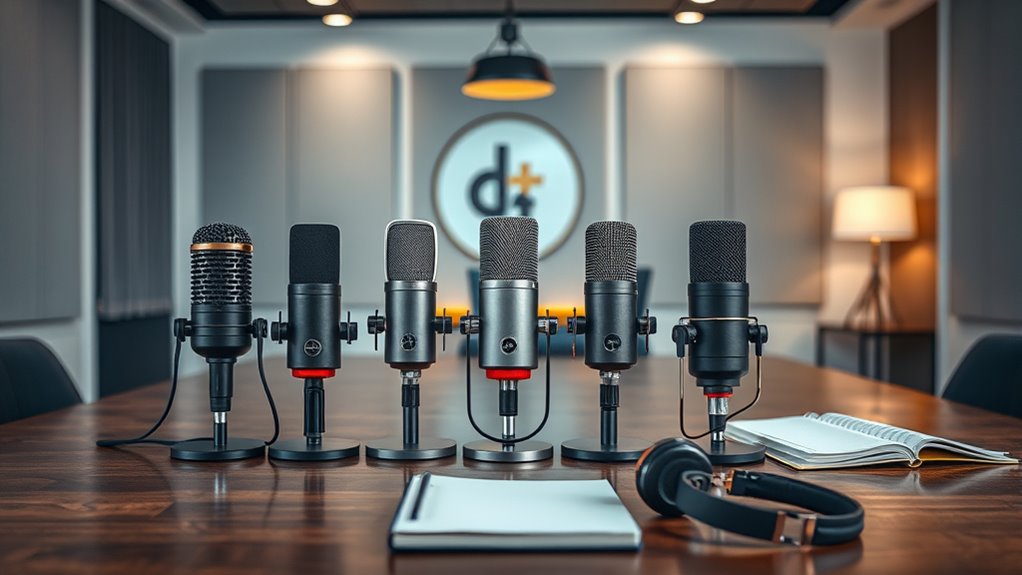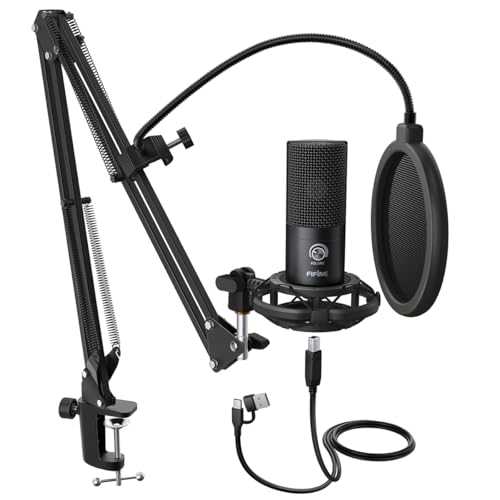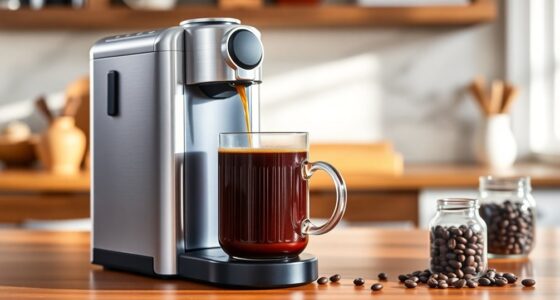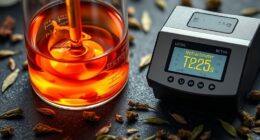If you’re searching for the best microphones for podcasters in 2025, I’ve got you covered! I’ve found excellent options like the InnoGear Microphone Stand, MAONO Wireless Lavalier, and Pyle Professional Dynamic Mic that balance quality and budget. Each mic offers unique features catering to different recording environments, whether you’re in a studio or on the go. Want to discover all the top choices and what makes them stand out? Keep exploring to find your perfect match!
Key Takeaways
- Condenser microphones are ideal for studio recordings, capturing detailed sound and vocal nuances in quiet environments.
- Dynamic microphones excel in noisy settings, rejecting background noise and ensuring clarity during live or outdoor recordings.
- USB microphones offer easy plug-and-play connectivity for beginners, while XLR microphones provide professional audio quality with greater flexibility for advanced setups.
- Portability is essential; lightweight and compact designs facilitate recording in various locations, especially for on-the-go content creators.
- Consider budget and durability; quality microphones range from $30 for basic models to over $200 for professional-grade options with added features.
InnoGear Microphone Stand, 2 Pack Tripod Boom Arm
If you’re a podcaster looking for a reliable and versatile microphone stand, the InnoGear Microphone Stand, 2 Pack Tripod Boom Arm is an excellent choice. I love how adjustable it is, with heights from 28.1 to 89.8 inches, making it suitable for everyone. The flexible boom arm extends and rotates, giving me the perfect angle for recording. Plus, its sturdy steel construction guarantees stability while weighing just 4.0 lbs. When I’m on the go, the included carrying bag makes transport a breeze. With compatibility for most microphones, it’s a fantastic option for any podcaster wanting functionality and convenience.
Best For: Podcasters and content creators who need a reliable, adjustable, and portable microphone stand for various recording situations.
Pros:
- Height adjustable from 28.1 to 89.8 inches, suitable for all ages and recording preferences.
- Sturdy steel construction ensures stability and durability while remaining lightweight at 4.0 lbs.
- Comes with a carrying bag for easy transport and storage, making it ideal for on-the-go use.
Cons:
- Some users may find the disassembly process slightly cumbersome for quick setups.
- The boom arm may require adjustment for optimal positioning, which could take time during setup.
- Limited to the compatibility of the included mic clips, which may not suit every microphone model.
Studio Podcast Dynamic Microphone with Desktop Stand and Pop Filter
Looking for a dynamic microphone that delivers professional sound quality for your podcasting needs? The Studio Podcast Dynamic Microphone is an excellent choice. With a frequency response of 40Hz-20kHz and a signal-to-noise ratio of 92dB, it captures vocals and instruments with impressive clarity. The sturdy all-metal design and adjustable desktop stand make setup a breeze. Plus, the included pop filter eliminates plosive sounds for cleaner audio. I appreciate the multiple connectivity options, including XLR and USB-C, catering to various devices. Overall, it’s a solid investment for anyone serious about their podcast or streaming quality.
Best For: Podcasters, streamers, and musicians seeking a high-quality dynamic microphone for versatile recording applications.
Pros:
- Professional sound quality with a frequency response of 40Hz-20kHz and excellent noise rejection.
- Durable all-metal construction and adjustable desktop stand for easy setup and optimal positioning.
- Multiple connectivity options (XLR and USB-C) make it compatible with various devices.
Cons:
- Some users report issues with low output levels or feedback, requiring careful placement and settings.
- Occasional loose USB connectors may affect reliability.
- A few customers have experienced muffled sound, suggesting that additional tuning may be necessary for optimal performance.
MAONO Wireless Lavalier Microphone for iPhone/Android/Camera/PC
For podcasters seeking professional-grade audio without the hassle of complicated setups, the MAONO Wireless Lavalier Microphone stands out as an exceptional choice. It’s incredibly lightweight and offers plug-and-play compatibility with iPhone, Android, cameras, and PCs. The studio-grade audio quality captures subtle details, while its advanced noise cancellation technology guarantees clarity in any environment. With a battery life of up to 9 hours and a transmission range of 300 meters, I can record without interruptions. Plus, the customizable voice filters minimize post-editing, making it perfect for interviews and live streaming. This mic truly elevates my podcasting experience!
Best For: Podcasters, vloggers, and content creators seeking professional audio quality without complicated setups.
Pros:
- Plug-and-play compatibility with multiple devices including iPhone, Android, cameras, and PCs.
- Studio-grade audio quality with advanced noise cancellation ensures clear sound in various environments.
- Extended battery life of up to 9 hours and a transmission range of 300 meters provide flexibility during recordings.
Cons:
- May require an app for optimal noise cancellation adjustments, which could be an extra step for some users.
- The lightweight design might feel less sturdy compared to bulkier microphones.
- Limited functionality in extremely noisy environments despite advanced noise cancellation features.
FIFINE Studio Condenser USB Microphone Kit (T669)
The FIFINE Studio Condenser USB Microphone Kit (T669) is perfect for podcasters who want a straightforward plug-and-play setup without the hassle of additional hardware. It connects directly to your PC or laptop, ensuring high-quality vocal recordings thanks to its cardioid condenser capsule that minimizes ambient noise. The kit includes a rugged boom arm, a shock mount, and a double pop filter to enhance sound clarity. With a 30-inch reach and easy positioning, it’s user-friendly for all skill levels. This microphone is ideal for various applications, delivering professional-grade audio whether for podcasts, voiceovers, or streaming.
Best For: Podcasters, streamers, and content creators seeking a high-quality, easy-to-use USB microphone for clear audio recordings.
Pros:
- Easy plug-and-play setup with no additional hardware or drivers required.
- Cardioid condenser capsule effectively captures vocal clarity while reducing background noise.
- Includes essential accessories like a boom arm, shock mount, and double pop filter for enhanced recording quality.
Cons:
- Not compatible with Xbox or phones, limiting versatility.
- May require additional space on the desk for the boom arm and setup.
- Performance may vary in very noisy environments despite noise reduction features.
Pyle Professional Dynamic Vocal Microphone (PDMIC59)
Podcasters seeking a reliable and durable microphone will find the Pyle Professional Dynamic Vocal Microphone (PDMIC59) an excellent choice. Its rugged, all-metal construction guarantees it withstands the rigors of any recording environment. The cardioid pickup pattern captures vocals while minimizing background noise, making it perfect for both studio and live settings. With an ultra-wide frequency response, this mic delivers brilliant sound quality. Plus, the included 15 ft. XLR-to-1/4 inch audio cable enhances its versatility. The integrated pop filter and ON/OFF switch add convenience, ensuring you can focus on creating great content without distractions.
Best For: Podcasters and performers seeking a durable, high-quality microphone that minimizes background noise and enhances sound clarity.
Pros:
- Rugged all-metal construction ensures durability in various recording environments.
- Cardioid pickup pattern effectively captures vocals while reducing off-axis noise.
- Integrated pop filter and ON/OFF switch add convenience for seamless use.
Cons:
- May require a separate audio interface for optimal use with computers.
- Limited to unidirectional pickup, which may not suit all recording scenarios.
- Some users might find the weight of the microphone cumbersome during extended use.
Factors to Consider When Choosing Microphones for Podcasters 2025
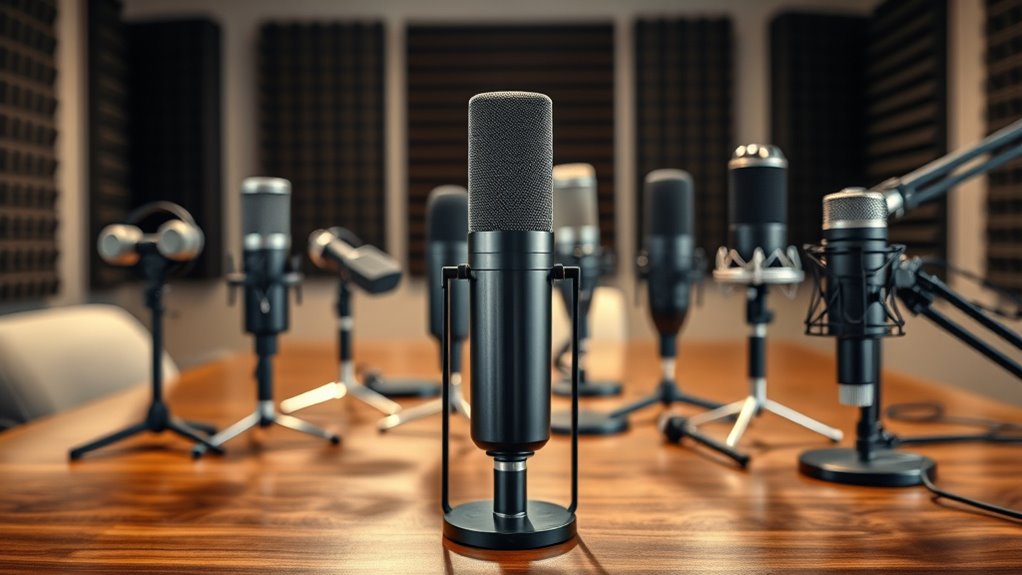
When picking a microphone for your podcast in 2025, I think it’s crucial to consider a few key factors. The type of microphone, audio quality, and connectivity options can really make or break your recording experience. Plus, don’t forget about portability and build durability, as these will affect how you use your gear on the go.
Microphone Type Selection
Choosing the right microphone type can considerably impact your podcast’s sound quality, especially if you’re recording in different environments. If you’re in a noisy area, dynamic microphones are perfect since they focus on your voice while minimizing background noise. For studio-quality recordings, consider condenser microphones; they capture detailed sound and have a wider frequency response. If you’re just starting out, USB microphones offer an easy plug-and-play option, making setup a breeze. For those looking for professional quality, XLR microphones require an audio interface but provide greater flexibility. Ultimately, if mobility is key, wireless microphones allow you to move freely and often come with noise reduction features, ensuring clarity no matter where you are.
Audio Quality Considerations
To guarantee your podcast sounds professional, you’ll want to contemplate a few key audio quality factors. First, look for a microphone with a wide frequency response range, ideally 40Hz-20kHz, so you can capture all the vocal nuances. A high signal-to-noise ratio, around 92dB or higher, is essential for minimizing background noise and ensuring clarity in your recordings. I recommend cardioid polar patterns since they focus on your voice while filtering out ambient sounds. Dynamic microphones are often the best choice for their durability and noise rejection, especially in less controlled settings. Finally, pay attention to sensitivity levels, around -51dB, which help capture detailed vocals without introducing distortion or requiring excessive gain.
Connectivity Options Available
As you explore the various connectivity options for microphones, it’s important to understand how each type can impact your podcasting setup. USB microphones are fantastic for beginners; they offer plug-and-play convenience, connecting easily to computers or mobile devices without extra gear. If you’re aiming for high-quality audio and flexibility, XLR microphones are the way to go, but you’ll need an audio interface or mixer. On the other hand, wireless microphones provide freedom from cables, perfect for dynamic recording situations or when you need to move around. Always consider compatibility with your devices and think about future scalability when selecting your microphone. Choosing the right connectivity option can markedly enhance your podcasting experience.
Portability and Storage
How important is portability when selecting a microphone for your podcasting needs? For me, it’s vital. I often record in various locations, and lightweight microphones that weigh less than 5 pounds make all the difference. I love how many portable options disassemble into smaller parts, allowing for easy storage in compact carrying cases. Wireless microphones are a game-changer too, as they eliminate the hassle of cables, giving me the freedom to move around while recording. Plus, compact designs, like lavalier or handheld microphones, are perfect for tight spaces or hands-free operation. When I can pack my gear in a protective case, I know it’ll stay safe during transit, ensuring my equipment lasts longer.
Build and Durability
When I choose a microphone for my podcasting, build and durability are at the forefront of my mind. I look for microphones made with all-metal construction or reinforced materials since they can handle frequent handling and transport without damage. A sturdy stand or mount is essential to maintain consistent audio quality during use. I also pay attention to the internal components; high-quality capsules and reinforced wiring are vital for longevity. If I plan to record outdoors, weather-resistant or dust-proof features are a must. Ultimately, the overall build quality affects how reliable the microphone will be over time, minimizing the chances of needing replacements. A durable mic is an investment in my podcast’s future.
Price and Budget
Choosing the right microphone for my podcast means being mindful of both price and budget. In 2025, I see options ranging from budget-friendly models around $30 to high-end microphones exceeding $200. Setting a clear budget helps me narrow down my choices, ensuring I don’t overspend on features I might not need. While pricier microphones typically deliver superior sound quality and durability, I’ve found that budget models can still perform well for beginners. It’s essential to balance what I can afford with the microphone’s features to meet my recording needs. I also consider the long-term value of investing in a slightly pricier model that offers better audio clarity and build quality, which can future-proof my podcasting setup.
Accessories and Compatibility
Selecting the right accessories and guaranteeing compatibility is crucial for a seamless podcasting experience. First, check that your microphone matches your recording device, whether it’s a computer, smartphone, or camera, by looking for compatible ports like USB, XLR, or Lightning. Additionally, consider whether it includes essential accessories—stands, shock mounts, pop filters, or cables—that enhance setup and sound quality. Make sure it supports your preferred connectivity options, like USB-C or wireless, for easy integration. Versatile mounting options, such as adapters for 3/8” to 5/8” screws, can guarantee compatibility with various stands and boom arms. Finally, look for microphones with universal compatibility features to simplify use across different devices and recording environments.
Frequently Asked Questions
What Is the Best Microphone for Beginners in Podcasting?
I believe the best microphone for beginners in podcasting is the Audio-Technica ATR2100x-USB. It’s affordable, versatile, and offers both USB and XLR outputs, making it perfect for starting out. I love its clear sound quality and durability. Plus, its plug-and-play design means I didn’t need any special equipment to get started. If you’re just beginning your podcasting journey, this mic is a fantastic choice that won’t break the bank!
How Can I Reduce Background Noise When Recording?
To reduce background noise when recording, I always choose a quiet space and close windows and doors. Using a good quality microphone helps too, as it picks up less ambient sound. I also position the mic close to my mouth and use soundproofing materials like foam panels or blankets. Finally, I apply noise reduction in my editing software to clean up any remaining noise. These steps really make a difference in my recordings!
Do I Need a Mixer for Podcasting?
When it comes to podcasting, you don’t need a mixer to get your feet wet, but it can certainly help you sound like a pro. I started without one and managed just fine, but once I added a mixer, it opened up a whole new world of sound control. If you’re planning to work with multiple audio sources or want to fine-tune your recordings, a mixer’s definitely worth considering.
What Audio Editing Software Is Recommended for Podcasters?
For audio editing, I highly recommend using software like Adobe Audition or Audacity. I’ve found Audacity to be user-friendly and free, making it perfect for beginners. If you’re looking for something more advanced, Adobe Audition offers powerful features that help me refine my sound. Don’t overlook GarageBand if you’re a Mac user; it’s surprisingly effective for podcasting. Just choose what fits your needs best, and start experimenting with your audio!
How Important Is Microphone Placement for Sound Quality?
Microphone placement can make or break your sound quality. It’s like having a gourmet meal but serving it on a paper plate. I’ve experimented with distances and angles, and trust me, the difference is astounding. Keeping the mic close reduces background noise while capturing your voice clearly. So, don’t underestimate it—spend time finding that sweet spot. Your listeners will appreciate the crispness, and you’ll feel more confident in your recordings.
Conclusion
As I wrap up this exploration of the best microphones for podcasters in 2025, I hope you feel equipped to find your perfect match in this sonic journey. Like a well-tuned instrument, the right microphone can elevate your voice, turning whispers into resonant stories. Remember, it’s not just about capturing sound; it’s about crafting an experience for your listeners. So, go ahead, choose wisely, and let your passion echo through the airwaves!
